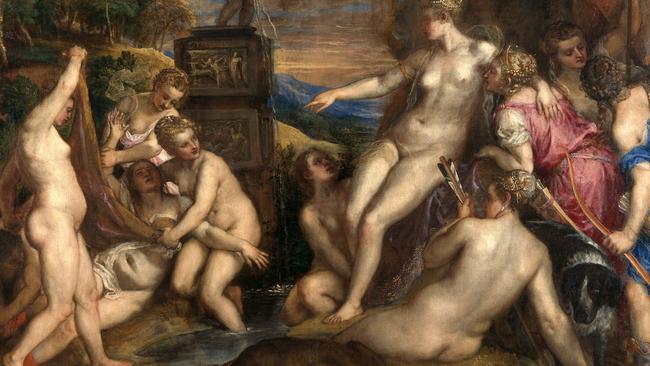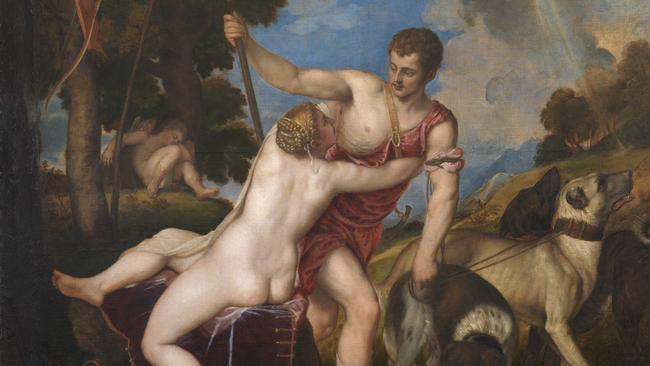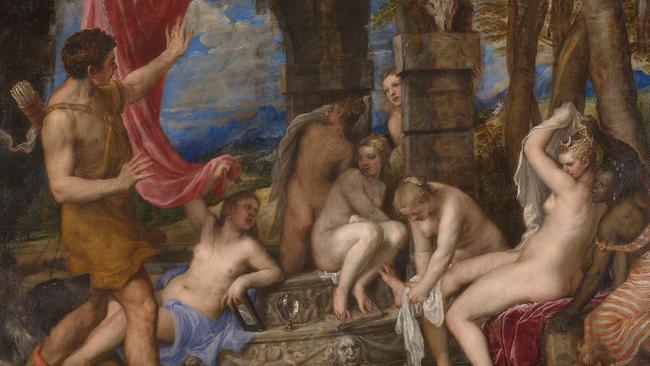The undeniable genius of Titian
Titian’s painting conjure a world of natural energy, of delight in the body, but also one that acknowledges the darkness of tragic fate.

In the middle of the 16th century, Titian, the greatest master of the School of Venice, was also the most famous painter in the western world. Even in the rival city of Florence, his genius was undeniable. Giorgio Vasari, who as a matter of principle included only deceased artists in his great series of Lives of the Artists, had made an exception in the first edition (1550) for his hero Michelangelo; in the second (1568) he extended that exception to one other artist, Tiziano Vecellio.
It was precisely during the intervening years that Titian painted a series of mythological pictures for Philip II, who was initially crown prince but became King Philip of Spain in 1556 upon the abdication of his father, the Holy Roman Emperor Charles V, who chose to spend his last years in monastic retirement. Through his abdication, Charles had redrawn the map of Europe: Spain and its possessions in the Netherlands, Sicily and Naples and the Americas were left to his son, and the crown of the Holy Roman Empire, with nominal suzerainty over the whole Germanic world as well as much of Italy, to his brother Ferdinand.
Titian had already worked for Charles V, so it was natural he would continue to be patronised by his son, whose portrait as a young man he had painted in 1551 and again in 1554. But the mythological subjects, with their prominent nudes, are a particularly interesting choice because Spain was one of the most straitlaced nations in Europe, and as the Reformation gathered steam at the very time these pictures were being painted, it became the centre of arch-reactionary Catholicism.
Compared to the gloomy and fanatical world of Spanish religiosity, Titian’s paintings are brimming with the energy, sensuousness and intellectual curiosity of the Italian Renaissance, a culture that had scarcely implanted itself in the Peninsula. That is not to say that they are simply expressions of joyousness: they have their own darker undertones, but their darkness arises from ancient ideas of fate and wilful divinities, not the Christian conception of sin.
There were seven pictures in the full series, but the last remained in Titian’s studio until his death: his late masterpiece The Death of Actaeon (1559-75), today in the National Gallery in London. The remaining six, all of which were delivered from 1553 onwards, but have been scattered since the 18th century, are at last reunited for a remarkable exhibition at the National Gallery in London (it is well worth visiting the gallery’s online resource hub dedicated to this exhibition).
The first work in the series was a new version of a picture originally painted around 1544-46 and now in the Museum of Capodimonte in Naples: Danae and the Shower of Gold (1551-53). The subject is the conception of the hero Perseus: Danae’s father, warned by the oracle that a son born to his daughter would cause his death, locked her away in a tower. But Zeus, or Jupiter in Latin, was enamoured by the girl and impregnated her in a shower of gold – pluvio auro as Ovid writes in his Metamorphoses, which became the mythological handbook of modern artists.

The Naples version has a Cupid on the right; this one almost exactly reproduces the figure of Danae, with her attitude of wonder and surrender, but replaces Cupid with an old woman reaching out her apron to collect the gold. As it happens, this second picture was given by the king of Spain to the Duke of Wellington in gratitude for his help in the fight against Napoleon, but was replaced with the third version, also with an old woman, that today hangs in the Prado in Madrid.
The second picture in the series, and the only one still held by the Prado, was also the reproduction of a work originally painted possibly 20 years earlier: Venus and Adonis, in which the awkward but strangely memorable twist of Venus’s body is borrowed from a small antique relief known as the Letto di Policleto that once belonged to Lorenzo Ghiberti.
The twist is motivated by the subject, for Venus is trying to stop her lover Adonis from going off to a hunt in which he will be fatally wounded by a boar. Her lament over the dying boy was imagined by the Hellenistic poet Bion, but it has deeper mystical echoes as well, for Adonis was originally a Semitic divinity, a consort of the eastern earth mother who played an important role in fertility ceremonies.
Each of these first two paintings can serve as an example of the layered and subtle way that classical mythology was interpreted in Renaissance art. At the most obvious level, it offered a collection of romantic and erotic subjects that resonated with humanistic concerns, an alternative or supplement to the scriptural subjects that dominated much artistic production.
But mythology also carried philosophical and even occult or hermetic meanings, particularly as it was interpreted by the Neoplatonic tradition. In this perspective, Zeus’s desire for a mortal girl could be a symbol of the love that draws the divine to unite itself with the human spirit. Titian’s own late and apparently brutal painting of Apollo flaying Marsyas alive could conceal a mystical insight into the way the divine can possess our soul and as Dante already suggests, free us from the prison of the flesh.
The third picture in the series was an original composition, although it recalls the first because its subject is Danae’s son: Perseus and Andromeda (c. 1554-56). The episode comes near the end of Perseus’s quest, when he is returning with the head of the Gorgon Medusa in a bag, for it petrifies any who looks at it. The king and queen of Ethiopia have been obliged to expose their daughter Andromeda, chained to a rock, to be devoured by a sea-monster sent by Poseidon; but Perseus slays the monster and marries Andromeda.
Titian seems to have taken the commission for Philip more and more seriously, for the next two pictures, Diana and Callisto and Diana and Actaeon (1556-59), are not only completely original, but large and ambitious, and conceived as a pair. Both are concerned with the goddess Artemis, or Diana in Latin, and even more specifically with the theme of the goddess bathing in a spring, accompanied by her nymphs.

From the earliest myths to a modern painter like Gustave Courbet, springs are feminine sexual symbols; rivers are gods, but springs are nymphs. And Artemis is a virgin goddess, which does not mean that she is asexual, but rather that she represents the powerful energy of potential sexuality, as distinct from its active expression in the person of Aphrodite or Venus. The spring in which she bathes is a highly charged symbolic place.
Both of the pictures deal with the violation of this sacred place and imply, without representing, the dire punishment that is to follow. The story of Callisto is also told by Ovid, and readers are highly recommended to listen to Ted Hughes reading his own free but eloquent translation of the episode on YouTube: search for Ted Hughes, Tales from Ovid, Part 1, Callisto and Arcas.
Callisto, either a nymph or the daughter of King Lycaon (who was turned into a wolf for his savage behaviour), was a follower of Artemis; but Zeus or Jupiter desired her and approached her disguised as Diana herself. He began to seduce her in this form and, when she realised the truth, forced himself on her. She became pregnant of course, because as another ancient literary source says, a god never fails in this regard.
Deeply ashamed of what she has done – or suffered – Callisto hides her growing belly until the day that the girls, after a day of hunting with their mistress, are going to bathe in a pool. Callisto tries to resist, but is playfully stripped by the others; her shame is revealed and Diana banishes her as impure. This is the moment represented in the painting, which is no sense the exuberant celebration of the naked female form that it may appear to a careless viewer.
What happens next is for the viewer to remember and imagine, and this is part of the interest of these pictures: not to tell the whole story, but to tell one crucial moment and leave the rest for us to muse over. After Callisto has given birth, Juno (Hera in Greek), who always hates her husband’s mistresses, willing or not, punishes her by turning her into a bear. Listen to Ted Hughes to find out how she comes to be, today, the constellation of Ursa Major.
Actaeon was the son of Aristaeus, himself the son of Apollo and the nymph Cyrene, who gave her name to the city and region in Libya.
The boy grew up to be a votary of Diana and thus dedicated to virginity and hunting. One day, however, he accidentally comes upon her bathing with her companions, and sees her naked body. He too is punished for this involuntary transgression. The goddess splashes him with water from the spring; he is turned into a stag and torn apart by his own hounds.
These are thus complex pictures, masterfully conceived and executed with breathtaking skill and feeling. And they express a worldview that is profoundly different from that of Christianity.
This is a world of natural and physical energy, of delight in the body and the organic world, but also one that acknowledges the darkness of chance and tragic fate. Transgression here is not a matter of sin in the Christian sense and cannot be remedied by repentance or forgiven by a priest.
Extraordinarily, these two paintings were given away by the newly-installed Bourbon king of Spain in 1704, and eventually made their way into a British private collection, from which they were jointly acquired in 2009 and 2012, after a massive fundraising campaign, by the National Gallery in London and the National Gallery of Scotland in Edinburgh. The last picture in the exhibition was also given away in 1704, but was acquired by the legendary art historian Bernard Berenson in 1896 on behalf of Isabella Stewart Gardner, and is now a treasure of the museum that bears her name in Boston.
The Rape of Europa (c. 1559-62), another sublime work, retells from Ovid a very ancient myth that may go back to Mycenaean times: how Zeus, desiring the daughter of King Agenor of Phoenicia, takes the form of a beautiful white bull and carries her off to the island of Crete, where she becomes the mother of King Minos and gives her name to a continent; her brother Cadmus, after searching for her in vain, founds the city of Thebes and ploughs the earth for the first time, marking the end of the golden age. Human life may be subject to incomprehensible forces, but it is interwoven with destiny and never insignificant.
Visit the National Gallery’s resource hub dedicated to the exhibition here.




To join the conversation, please log in. Don't have an account? Register
Join the conversation, you are commenting as Logout